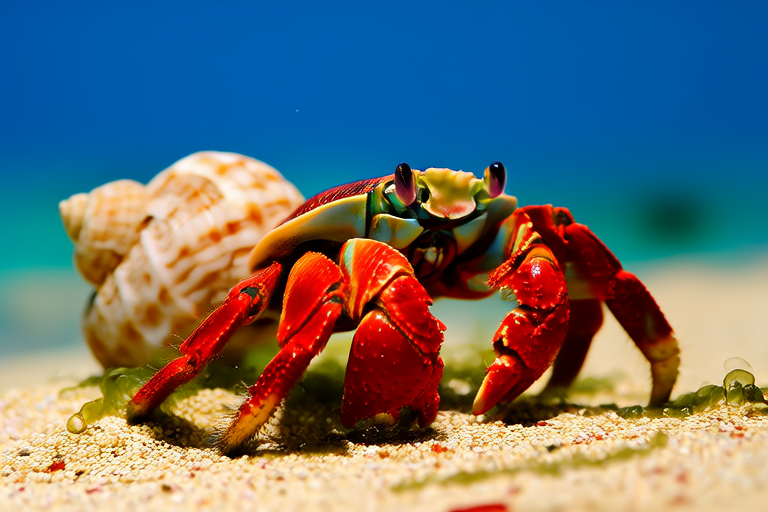Top Secrets to Keeping Your Hermit Crab Happy and Healthy
Welcome, fellow hermit crab enthusiasts! Whether you’re a seasoned keeper or just starting your journey into the world of these fascinating creatures, this guide will provide you with invaluable secrets to ensuring your hermit crab lives a long, healthy, and happy life. From habitat setup to diet specifics and beyond, we’ll cover everything you need to know to be the best hermit crab owner possible.
Setting Up the Perfect Habitat
The first step in keeping your hermit crab happy and healthy is creating a suitable environment. Hermit crabs are tropical creatures that thrive in environments that mimic their natural habitats. Start by selecting an appropriately sized tank; the general rule is one gallon of space per crab. Ensure the enclosure has a secure lid to prevent escapes.
- Substrate: Use a mix of sand and coconut fiber, which provides both stability and moisture retention. This substrate mimics the soft, sandy beaches where hermit crabs naturally reside, allowing them to burrow and feel safe.
- Hiding spots: Include various hiding places like caves, shells, and small tunnels. These spaces offer security and help reduce stress.
- Water dishes: Provide two water dishes: one with fresh water and another with salt water. The salt water should be prepared using marine salt specifically designed for aquariums, mixed to a salinity level of 1.023 to 1.025. This is crucial because hermit crabs absorb moisture through their gills, which require salt water to function properly.
Temperature and Humidity Control
Maintaining optimal temperature and humidity levels is vital for your hermit crab’s well-being. Hermit crabs are ectothermic, meaning they rely on external heat sources to regulate their body temperature.
- Temperature: Keep the enclosure between 75°F and 85°F (24°C to 29°C). A heat mat placed under one side of the tank can help maintain this range, allowing crabs to thermoregulate by moving between warmer and cooler areas.
- Humidity: Aim for humidity levels of 70% to 80%. Regular misting and a hygrometer to monitor humidity levels will ensure your crabs stay hydrated and comfortable.
Diet Specifics
A balanced diet is key to your hermit crab’s health. Hermit crabs are omnivorous scavengers, eating a wide variety of foods in the wild.
- Fruits and vegetables: Offer a mix of fresh fruits and vegetables like bananas, apples, carrots, and leafy greens. Avoid citrus fruits as they can cause digestive issues.
- Protein sources: Provide occasional protein-rich foods such as boiled eggs, fish, and insects. This helps meet their nutritional requirements.
- Vitamins and minerals: Supplement their diet with calcium and vitamin powders to promote strong exoskeleton growth.
- Water: Ensure fresh water is always available, as dehydration can lead to molting problems and other health issues.
Shell Selection
Hermit crabs rely on shells for protection and comfort, so providing a variety of options is important. Choose shells that are slightly larger than the current shell your crab is wearing, allowing room for growth. Shells should have smooth interiors and no sharp edges. Periodically check and replace any damaged or worn-out shells.
Tank Mates Compatibility
Hermit crabs are generally social animals and can coexist peacefully with others of their kind. However, overcrowding should be avoided, as it can lead to stress and competition over resources. When introducing new crabs, quarantine them first to prevent the spread of diseases.
Regular Health Checks
Performing regular health checks is essential for early detection of potential issues. Look for signs of illness such as lethargy, loss of appetite, or discolored exoskeletons. If you notice any concerning symptoms, consult a veterinarian specializing in exotic pets.
Enrichment Activities
Providing mental stimulation and physical exercise is crucial for your hermit crab’s overall well-being. Rotate toys and enrichment items regularly to keep things interesting. Consider adding tunnels, bridges, and climbing structures to encourage exploration and activity.
Call to Action
We hope this guide has provided you with valuable insights into caring for your hermit crab. Share your own experiences, tips, and stories in the comments below. Together, we can create a supportive community of hermit crab lovers who are dedicated to providing the best possible care for these wonderful creatures.
